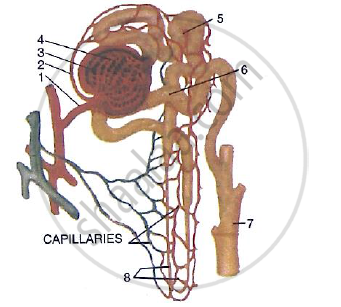Advertisements
Advertisements
Question
Name the main nitrogenous waste in the human blood. How is it removed from the blood?
Solution
The main nitrogenous waste in the human blood is urea. The kidneys remove the urea from the blood and excrete them in the form of a dilute solution called urine.
Kidneys are the main excretory organ of the human body. There are millions of nephrons in each kidney. Each nephron contains a renal corpuscle and a renal tubule. The renal corpuscle consists of capillaries called the glomerulus, enclosed by a capsule called Bowman's capsule. The blood is filtered in the glomerulus and the filtrate travels through the renal tubules. Here, the materials needed by the body are reabsorbed, while the wastes (like urea) are collected and excreted in the urine.
APPEARS IN
RELATED QUESTIONS
Describe the structure and functioning of nephrons.
Give biological reasons for the following statements: There is frequent urination in winter than in summer
Name the procedure used in the working of artificial kidney.
Name a waste gas released by the plants only during the daytime.
With which human organ system (or human systems) is glomerulus associated?
The excretory unit in the human excretory system is called:
Put a tick mark (✓) against the most appropriate alternative in the following statement :
In human beings, urea is produced in :
Differentiate between
tannins and resins
Name the following:
The part of kidney tubules where the term urine is first used for the fluid in it.
Given below is a set of five terms. Rewrite the terms in their correct order so as to be in logical sequence.
Afferent arteriole, renal vein, secondary capillary network, glomerulus, efferent arteriole.
Differentiate between the following pairs of term :
Renal cortex and renal medulla
The following diagram represents a mammalian kidney tubule (nephron) and its blood supply.

Parts indicated by the guidelines 1 to 8 are as follows:
1. Afferent arteriole from renal artery
2. efferent arteriole
3. Bowman’s capsule
4. Glomerulus;
5. Proximal convoluted tubule with blood capillaries;
6. Distal convoluted tubule with blood capillaries;
7. collecting tubule;
8. U-shaped loop of Henle
Study the diagram and answer the question that follow:
Where does ultrafiltration take place?
Choose the odd one out in the following series:
Renal fat, renal capsule, nerve.
Differentiate between:
Ureter and Urethra.
Write the functional activity of the following structure: Renal vein
Explain the importance of soil for plant growth.
Give two examples of the following:
Nitrogenous waste
The process of removal of unwanted metabolic wastes from the body is called ______.
The main nitrogenous waste formed in the human body:
